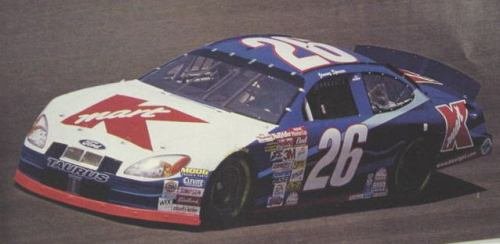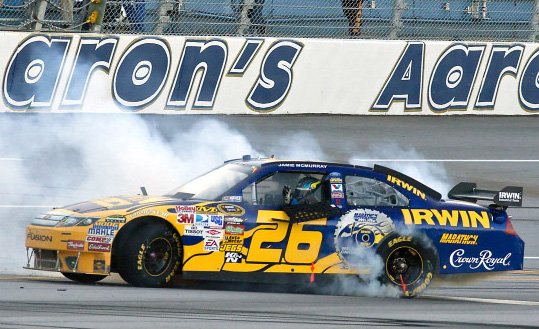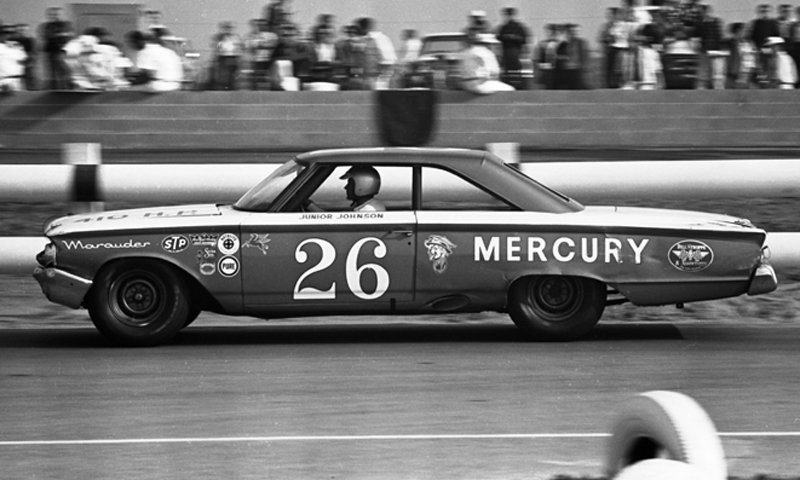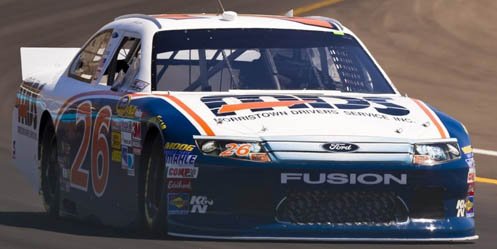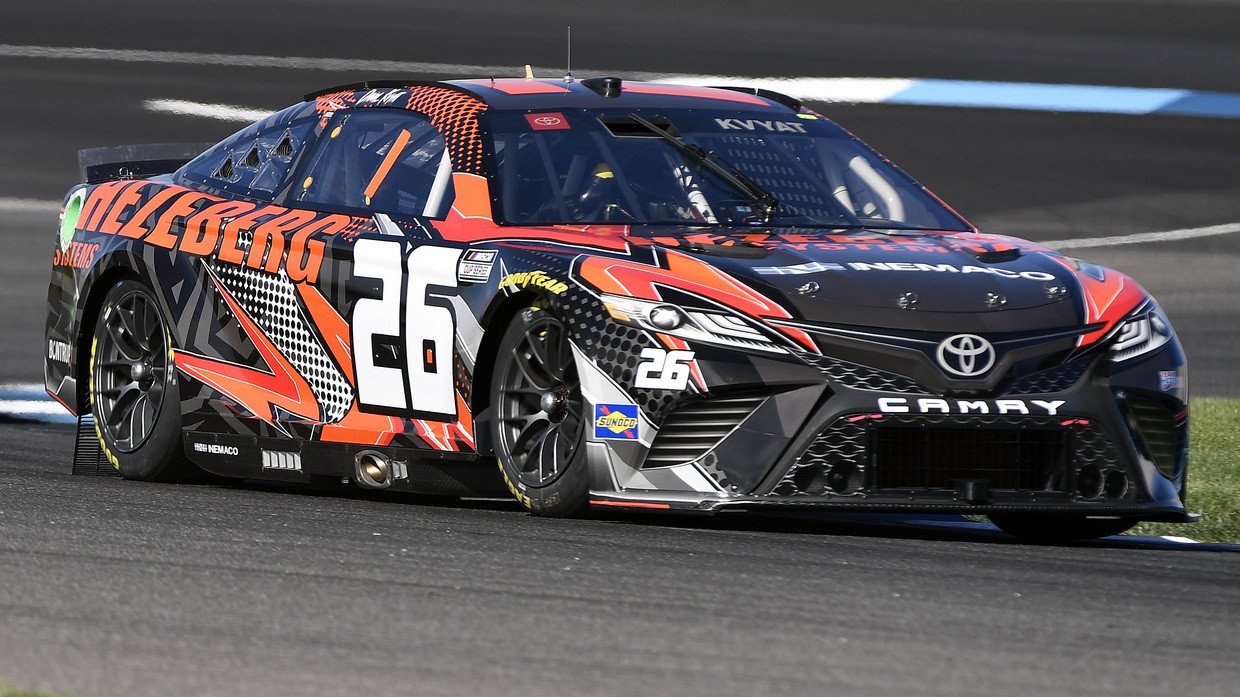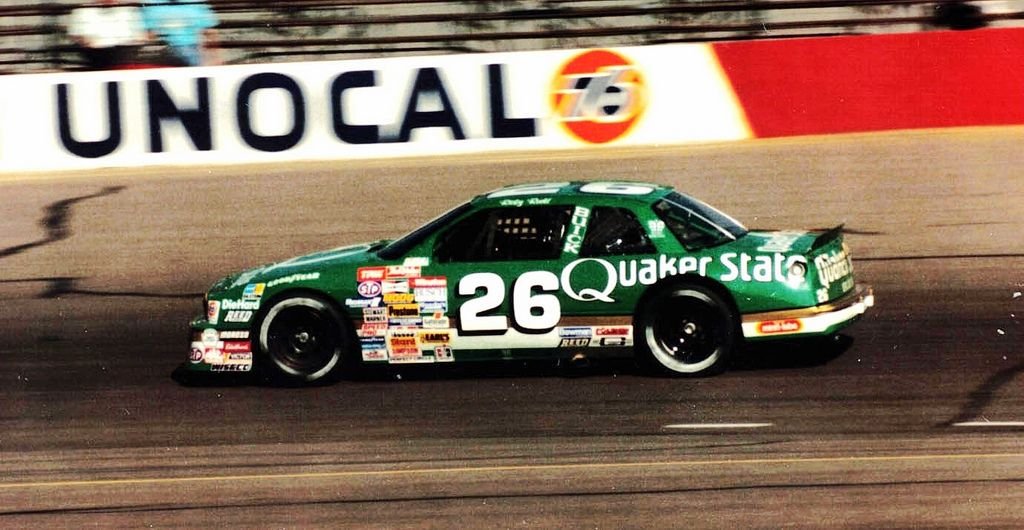
In NASCAR Cup Series competition the #26 car has started 1105 races and has 22 wins, 36 poles, 116 top 5s, 259 top 10s, and 373 DNFs.
Joe Ruttman started 29 races during the 1986 season in the #26 Quaker State Buick Regal owned by Drag Racing Legend Kenny Bernstein‘s team “King Racing.” Morgan Shepherd drove the number both before Ruttman and after for 31 starts in 1985 & 1987.
Ricky Rudd earned 2 wins in his 58 starts in the #26 from 1988-1989. Rudd joined King Racing beginning in 1988. He struggled with engine failures all season long and finished 11th in the standings, his worst points finish in eight years. After his only win of 1989, which came at the inaugural Sears Point event, Rudd departed the operation, and in 1990 he signed with Hendrick Motorsports to drive the #5 Levi Garrett Chevrolet Lumina.
Brett Bodine has the most starts in #26 with 147 from 1990-1994 including Brett’s only career win. Driving the #26 Quaker State Buick Regal for champion drag racer Kenny Bernstein, Bodine won his first race at North Wilkesboro Speedway , which came under some controversy. During a long 17-lap caution flag, scoring was mixed up, and some felt that Darrell Waltrip was robbed of the win because of the error. It was found that Waltrip was up front but by the time it was clear that Waltrip won, Bodine had already been declared the winner officially. When Waltrip protested Bill France said “You leave this kid alone DW…it is his first win and you will win more races.” The win stood, and before the season was over, Bodine had won his first pole position at the fall event at Charlotte Motor Speedway and was 12th in the championship standings. Bodine wasn’t able to equal his 1990 effort, and parted ways with Bernstein after the 1994 season. Sprint Car Champion Steve Kinser was hired to replace Bodine in 1995, but after only 5 races was replaced by Hut Stricklin for the remainder of the year.
Johnny Benson Jr. drove the Roush Racing #26 General Mills/Cheerios Ford Taurus in 66 races in the 1998 & 1999 seasons. In 1998, he missed the season opening Daytona 500, then finished 30th at the following race. He then had a streak of no finishes worse than ninth over the next five races and rose as high as tenth in points, before he finished 38th and 41st in the next two races. For the rest of the season, his best finish was ninth and he qualified no higher than second. He finished 20th in points. Benson had numerous crew chiefs in 1999. He had two top 10 finishes and finished 28th in the final standings. After a long negotiation, he was able to buy out his contract and announced he would leave Roush.
Jimmy Spencer drove #26 for 70 starts from 2000-2001. After a 20th-place finish in 1999, Winston left the Travis Carter #23 team, and Kmart became the team’s new sponsor, causing Spencer to switch to the #26 to accommodate the new sponsor, who was already backing the #66 car driven by Spencer’s teammate, Darrell Waltrip. Spencer had two top-fives and in 2001 won the pole positions at Indianapolis Motor Speedway and Lowe’s Motor Speedway and advanced to sixteenth in points. He departed the team at the end of the season.
In the twilight of Travis Carter’s team the #26 was fielded by several drivers in 2002 before lack of sponsorship dove the team out of business. The drivers included Todd Bodine with 21 starts, Joe Nemechek with 7 starts, Frank Kimmel with 6 starts, and Geoff Bodine with 1 start. Yep, all 3 Bodine Brothers have driven #26.
Jamie McMurray started #26 a total of 144 times between 2006-2009 including 2 wins. After leaving Ganassi Racing following 2005, McMurray was originally to go to the #6 Ford in 2006, but since Mark Martin announced he would race for another year, McMurray instead took over for Kurt Busch in the #97 Crown Royal/IRWIN Tools Ford (which was then renumbered #26). 2006 was a hard season for McMurray. McMurray’s best finish of the 2006 season came at Dover International Speedway, where he finished second after leading the most laps. McMurray would record three top fives, seven top tens and finish a disappointing 25th in points.On June 22, 2007, he won his third career Cup pole, for the Toyota Save/Mart 350. On lap 1, he was passed by Robby Gordon. With about 45 laps left, McMurray took the lead and dominated the final laps, but with 7 to go Cup rookie and his future teammate Juan Pablo Montoya passed him and held him off until McMurray eventually ran out of gas with 2 to go and resulted 37th. On July 7 at the Pepsi 400, McMurray led a few laps in the first stages. However, on lap 30, McMurray was then black-flagged by NASCAR for slipping out of bounds. He then spent the rest of the race charging back through the field eventually getting back to the front on lap 155. McMurray then led the final stages but battled Kyle Busch for five laps. On the last lap, Busch was the leader next to McMurray and charged to the finish, but at the last second, McMurray charged one last time and barely beat Busch to win the Pepsi 400 for his second career Cup win. The margin was 0.005 of a second, and the finish resembled the Daytona 500 of the year’s finish when Kevin Harvick beat Mark Martin at the last second of the race that year. The photo finish was the closest in Daytona International Speedway history and tied for the second closest finish (1993 DieHard 500) since the advent of electronic scoring in 1993. McMurray finished the year 17th in the point standings.
In the beginning of the 2008 season, McMurray encountered a string of poor finishes that relegated him to 36th in points and thus not guaranteed a spot when NASCAR reached the spring Martinsville race. McMurray finished 16th in the standings. On November 1, 2009, McMurray won the AMP Energy 500 at Talladega after leading over 20 laps and passing David Stremme with 8 laps to go. He then survived a green-white checkered finish to earn his second restrictor-plate win. Roush released him and the #26 team at the end of the season due to NASCAR’s four team limit and the expiration of Roush Fenway Racing’s exemption that allowed a 5th team. McMurray decided to ask former boss Chip Ganassi for another chance following his disastrous era on Roush-Fenway Racing and Ganassi granted him a contract to let him drive the #1 car for his merged team with Dale Earnhardt Inc., Earnhardt Ganassi Racing.
Earl Brooks started #26 109 times from 1962-1973. As one of the earliest professionals of any sport, he played the game simply to feed his family and to be a breadwinner to his family. Brooks never had the money or the time attract corporate sponsors for his racing team. His “second job” was being a mechanic for a garage on Lynchburg’s Mayflower Drive; where he worked from Monday to Friday to pay off any bills that NASCAR couldn’t help with. In the summertime, Earl would wear sandals while racing; something that would eventually become banned as NASCAR became more safety conscious. Like any other driver who raced during the formative years of NASCAR, Brooks was a humble man who would sometime race for meager “awards” like a block of cheese or a tin of crackers to eat for a snack after the race. While Richard Petty and David Pearson could buy new parts for their vehicles through their corporate sponsors spending money like there was no tomorrow, Earl had to scrounge around for vehicle components. Due to Brooks being unable to win a race in the NASCAR Cup Series, he is ineligible for the NASCAR Hall of Fame as a driver.
Junior Johnson raced his #26 car 40 times from 1963-1966 including 12 wins. As an owner Johnson fielded the #26 with many of the sport’s great names like Fred Lorenzon , Curtis Turner , Bobby Isaac , Darel Dieringer and LeeRoy Yarbrough
In 2014 Cole Whitt started all 36 races for Swan Racing.
Dave Terrell started 34 races in #26 from 1953-1954. He drove #26 in exactly half of his career starts.
Josh Wise competed for the Rookie of the Year in 2012 driving the #26 in 30 starts for Front Row Motorsports.
In 2015 Jeb Burton started 17 races in #26 before switching teams with his BK Racing teammate J.J. Yeley who made 11 starts. Josh Wise also made 1 start in the car in 2015. In 2016 Robert Richardson Jr. made 1 start in #26: the Daytona 500.
In 2022 Daniil Kvyat made three starts in the NASCAR Cup Series for Team Hezeberg, with his car using the same number he used in Formula One, 26. He made his NASCAR Cup Series debut in the Verizon 200 at the Brickyard at the Indianapolis Motor Speedway road course, finishing in 36th position after retiring from the race with suspension issues. He finished 36th again at Watkin Glen and 39th at the Charlotte Roval. He also piloted the #26 in the XFINITY Series for Sam Hunt Racing at the Roval, finishing 15th.
Fictional driver Ricky Bobby drove the #26 in the comedy movie “Talladega Nights:The Ballad of Ricky Bobby”
Other notable names in #26
David Stremme, 11 starts
Dave Marcis, 6 starts
Boris Said, 5 starts
Ken Schrader, 1 start
Tony Raines, 1 start
Michael Waltrip, 1 start
Dick Trickle, 1 start
Bill Elliott, 1 start
David Pearson, 1 start





